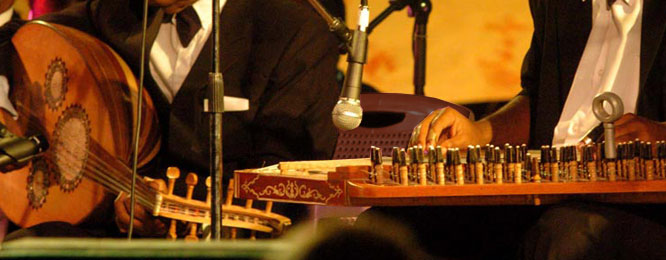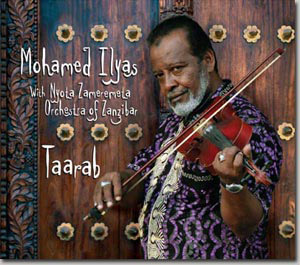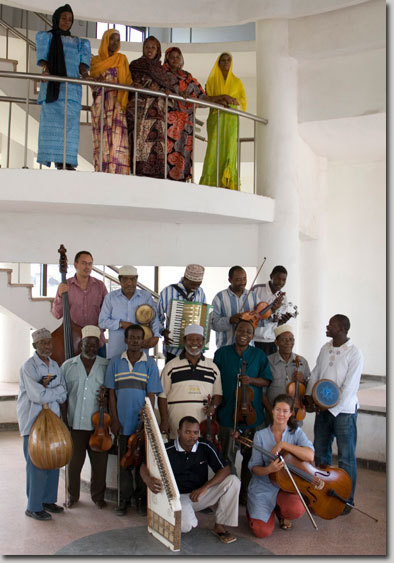
Mohamed Ilyas
Mohamed Ilyas
with Noyota Zameremeta Orchestra of Zanzibar
‘Taarab’ CD album
Chiku~Taku Records CHITA 01
Track listing:
- Amenipokeya
- Panya
- Bahati Haina Kwao
- Watu Wananiuliza
- Hakika Nakupenda
- Miujiza
- Nisafirishe Kwa Huba
- Pendo
- Si Rahisi
- Moyoni Sina Nafasi
- Walodhani Ni Mzaha
- Ewe Bibi Mwenye Enzi

Taarab Music runs all down the coast of East Africa and inland some ways. But it is in Zanzibar where the Arab and African worlds of music meet to the most powerful effect. Add Latin and Indian rhythms to this string laden music and you have a heady mix of sound from the Spice Island.
There is a long tradition of music in Zanzibar, going back to the latter part of the 19th century when the Sultan Seyyid Barghash bin Said first brought in Egyptian musicians to entertain at court.
In 1905 Nada Ikhwani Safaa, a form of gentleman’s club was founded. In time they took up instruments and started the tradition of large Taarab Orchestras on the Island.
Siti Binti Saad, the working class potter turned singer Africanised the music and popularised it with often highly charged political and social comment. From 1928 until her death in 1950 she recorded some 150 shellac records and is by far the most important individual figure in Taarab, even to this day.
It is this long tradition that Mohamed Ilyas draws on and he is undoubtedly the finest exponent of the Taarab singing still performing. He has a deep rich voice that can still soar, never twice phrasing in exactly the same way, and always articulating the poetry of Taarab, with an accuracy and depth of emotion that is now unmatched in the tradition.
For many years he was a stalwart of Nada Ikhwani Safaa, before forming his own group Twinkling Stars, co-starring with the doyenne of Zanzibari music Bi Kidude, the last direct musical descendant of Siti Binti Saad.
Mohamed lived the life of a star performer through his own dark years, during which his life fell in tatters reflecting the despair often expressed in the poetry that he sang. He never stopped writing and performing however, though he was rarely afforded the opportunity to record during this time.
But there were those who kept faith with him and he has now emerged with a group of mostly younger musicians, including the multi instrumentalist Mohamed Issa Matona and the new king of the ganun Rajab Suleiman. Augmented by the very adventurous contra bass playing of Øystein Bru Frantzen and reintroducing the cello to the music with Hanna Trondalen, both Norwegian, this 17 piece group were captured live in the Sauti za Zanzibar Radio Studio in Stone Town over a week of sessions in 2008.
The studio was a real discovery and engineer Adam Skeaping, who has worked with all of the major classical orchestras in Britain, was heard to say that it was indeed one of the finest rooms he had ever worked in. This allowed the whole orchestra to be cut live off the floor.
So the Nyota Zameremeta Orchestra of Zanzibar was born in a welter of rehearsal, drama and line up changes, all orchestrated by the indomitable Mariam Hamdani, one time partner of Mohamed Ilyas, who despite it all kept the faith.

Mohamed Ilyas and the Noyota Zameremeta Orchestra of Zanzibar. © Fenstein
So this either is the last great Taarab record or the start of a new era for this epic music. As the tyranny of the keyboard and drum machine, aligned with the most crass of approaches to the lyrics and music, takes over locally, the tradition of the large string orchestra maybe has to seek an audience elsewhere. The allegorical lyrics still retain their force in certain quarters, but gone are the days of the spectacular concerts attended by thousands of people, in which the society acted out it’s affairs, politics and disagreements in a very public but subtle manner through the words and music of the Taarab.
All of this is on the Mohamed Ilyas album, but played here with a rhythmic accent that has always been there in the music but often left understated. The romantic heart is still expressed however, but more than ever contrasted with the turbulent undertow that is the very essence of Zanzibari society ~ an intensely Island culture shouting it’s music in a very intense but elegant way.

His Excellency Ali Juma Shamuhuna, Deputy Chief Minister of the Zanzibar Government and Minister for Information, Culture and Sport visits Sauti ya Tanzania Zanzibar Studio during the recording by Mohamed Ilyas with Nyota Zameremeta Orchestra of Zanzibar [As reported by the Zanzibar Leo]
If you like Mohamed Ilyas, then Chiku~Taku recommends that you check out these classic recordings from 1988.
